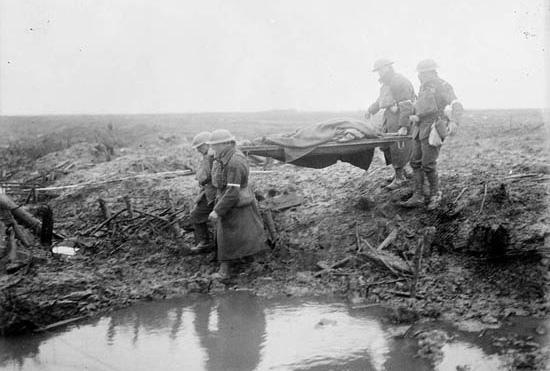Bullseye
First World War Audio Archive
Bullseye
Transcript
Hill 62 Memorial Belgium.
Well, the rest period in the army, you don’t just lie down and go to sleep. It went on to very intensive training and in thisCourtrai Memorial Belgium.
training, the machine gun crews from each company had what theyLe Quesnel Memorial Belgium.
called a shoot-off to see which was the best machine gun crew and it so happened that my machine gun crew won “D” companyGueudecourt Memorial France.
and Hughie Cairns machine gun crew won “A” company, and I don’t know who won “B” and “C,” it doesn’t matter. Anyway, we had to goDury Memorial France.
have a shoot-out, go on back into the back and using the coverMonchy Memorial France.
that was available and any ravines or little draws to get up to a set of targets to make the best use of all that to get up to these targets. And then at a certain spot you put your gun up andPasschendaele Memorial Belgium.
when they blew the whistle you started to fire the machine gun at a target. You had the target in front of you. Well, my machineMasnières memorial France.
gun number one was Charlie Johnston and he had what they called a first position stoppage right off the bat. So I just fell downBourion Wood Memorial France.
beside him and rolled him over and pulled the cocking handle back and let her go and I stayed down there and kept firing until they blew the whistle again and then you stopped. And then they wentCourcelette Memorial France.
out to try to count the number of bullseyes that you had made. Well, apparently, on the machine gun, on the target that I was firing at, I had just cut the centre right out of, right out ofBeaumont-Hamel Memorial France.
the bullseye and I had beaten Hughie Cairns on the shoot. Well, then I was supposed to go down to brigade, shooting in theSt. Julien Memorial Belgium.
brigade but in the meantime the big push on the 8th of August came along and that brigade shoot never came off. I sure wouldCanadian National Vimy Memorial France.
have loved to have a shot, a crack at that brigade shoot. That would have been something. That would have been something.Description
Mr. Smith describes competition among the machine gun crews as part of his training regimen in the war zone.
Allan A ‘Spike’ Smith
Allan A ‘Spike’ Smith was born in Minto, Manitoba on May 7, 1894. Mr. Smith enlisted while attending the University of Saskatchewan, joining the 196th Battalion. He did his basic training at Camp Hughes, Manitoba. Once overseas, he was at Camp Seaford in England when he was selected to reinforce the 46th Battalion. He saw his first action just prior to Vimy, and was wounded by shrapnel at the Chalk Pits. He returned to action at Drocourt-Queant, and was again wounded by shrapnel. He later returned to Passchendaele. He received a Military Medal for bravery. After the war, Mr. Smith became a farmer, coached a women’s volleyball team, and became an agriculture inspector. He died on August 12, 1981.
Meta Data
- Medium:
- Video
- Owner:
- Veterans Affairs Canada
- Duration:
- 2:13
- Person Interviewed:
- Allan A ‘Spike’ Smith
- War, Conflict or Mission:
- First World War
- Location/Theatre:
- Europe
- Branch:
- Army
- Units/Ship:
- 196th Battalion
- Rank:
- Lance-Corporal
- Occupation:
- Infantryman
Attestation
Related Videos
- Date modified:




